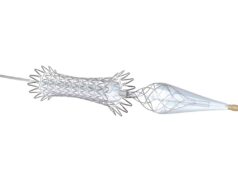
The first patient has been enrolled in the Embrace TDD (targeted drug delivery) clinical study that will evaluate the use of the SynchroMed II intrathecal drug delivery system (Medtronic pain pump) as an alternative to oral opioids for patients with chronic intractable non-malignant primary back pain with or without leg pain.
The Medtronic pain pump provides effective pain relief at a fraction of the oral dose with fewer side effects and may help reduce or eliminate the use of oral opioids.1-7 The Embrace TDD study will follow patients who wean completely from all oral opioids and have a successful intrathecal drug trial. The first patient was enrolled by John A Hatheway, in Spokane, USA.
Oral opioids are widely used to treat pain; however, there is limited evidence on the effectiveness and benefits of long-term oral opioid therapy.8 Given the current opioid epidemic and ongoing pain management crisis, there is a need to better understand solutions that effectively address chronic pain and support the elimination of oral opioids.
There is evidence that oral opioid tapering and elimination may improve pain relief and allow for treatment with a lower effective dose of intrathecal medication compared to a combination of oral and intrathecal treatment.6 The Embrace TDD study was designed to further understand the impact of an opioid-free period prior to TDD treatment on patient outcomes.
The Embrace TDD study is a prospective, multicentre, post-market study that will enrol approximately 100 patients with chronic intractable non-malignant primary back pain with or without leg pain at up to 15 sites in the USA. Patients will wean from all oral opioids prior to initiating intrathecal therapy.
The study will assess pain control and opioid-related side effects at six months following a route of delivery change to intrathecal preservative-free morphine sulfate. Patients taking a daily systemic opioid dose of ≤ 120 Morphine Milligram Equivalents (MME), who are candidates for TDD, are eligible. Patients will be followed for 12 months.
References
- Hamza M, Doleys D, Wells M, et al. Prospective study of 3-year follow-up of low-dose intrathecal opioids in the management of chronic nonmalignant pain. Pain Med. 2012;13(10): 1304-1313.
- Smith TJ, Staats PS, Deer T, et al. Randomized clinical trial of an implantable drug delivery system compared with comprehensive medical management for refractory cancer pain: impact on pain, drug-related toxicity, and survival. Journal of clinical oncology: official journal of the American Society of Clinical Oncology. 2002;20(19):4040-4049.
- Deer T, Chapple I, Classen A, et al. Intrathecal drug delivery for treatment of chronic low back pain: report from the National Outcomes Registry for Low Back Pain. Pain Med. 2004;5(1): 6-13.
- Atli A, Theodore BR, Turk DC, Loeser JD. Intrathecal opioid therapy for chronic nonmalignant pain: a retrospective cohort study with 3-year follow-up. Pain Med. 2010;11(7):1010-1016.
- Hatheway JA, Caraway D, David G, et al. Oral opioid elimination after implantation of an intrathecal drug delivery system significantly reduced health-care expenditures. Neuromodulation : journal of the International Neuromodulation Society. 2015;18(3):207-213.
- Grider JS, Etscheidt MA, Harned ME, et al. Trialing and maintenance dosing using a low-dose intrathecal opioid method for chronic nonmalignant pain: a prospective 36-month study. Neuromodulation : journal of the International Neuromodulation Society. 2016;19(2):206-219.
- Onofrio BM, Yaksh TL. Long-term pain relief produced by intrathecal morphine infusion in 53 patients. J Neurosurg. 1990;72(2):200-209.
- Chou R, Deyo RA, Devine B, et al. The effectiveness and risks of long-term opioid treatment of chronic pain: evidence report/technology assessment No. 218. AHRQ publication no. 14-E005- EF. Rockville, MD: Agency for Healthcare Research and Quality; 2014.










